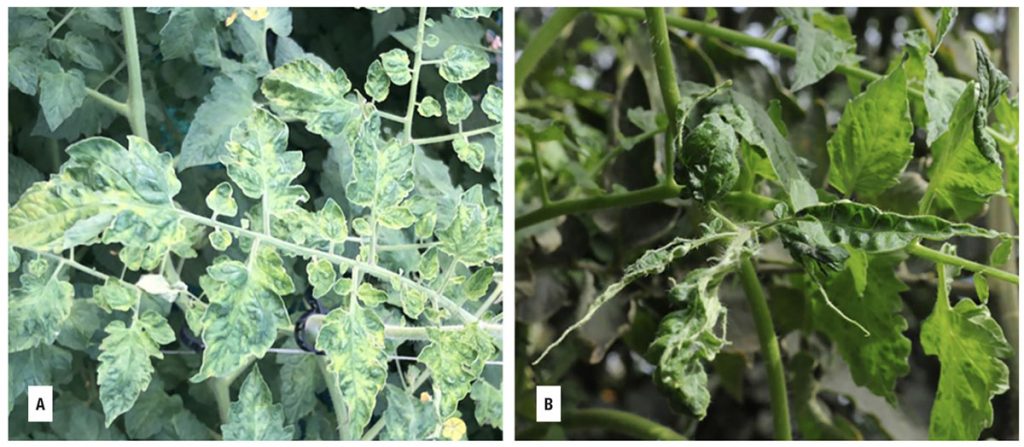
Photos by Salvatore Davino and Camille Picard
By Ozgur Batuman and Salih Yilmaz
Tomato brown rugose fruit virus (ToBRFV) is a highly contagious, devastating and economically important plant virus. It mainly threatens greenhouse-grown vegetable crops worldwide, especially tomatoes and peppers.
ToBRFV is very similar to other tobamoviruses, such as tomato mosaic virus (ToMV) and tobacco mosaic virus (TMV), two tomato-infecting viruses common to most Florida growers. Although ToBRFV was found on imported tomatoes sold in grocery stores and a few community gardens in Florida in 2019, it has not been found in any commercial production field.
Symptoms and Spread
Since ToBRFV (and tobamoviruses in general) is seed-associated and mechanically transmitted (such as touching by hand or by equipment), it can easily be passed to nearby tomato plants. ToBRFV particles are very robust and can survive up to several years in soil and on contaminated areas including seed coats, benches, ropes, plastic containers and field equipment.
All infected plant material — including leaves, petioles, stems, roots and fruit — contain high virus titers, so handling these plant parts can cause disease spread. Although undamaged fruit surfaces may not seem to have the virus, juice and other edible parts are highly infectious.
There is no insect vector for ToBRFV, but bumblebees were shown to carry the virus in greenhouse settings.
Introduction and Prevention
Preventing the introduction of ToBRFV in Florida tomato production areas is very important. First and foremost, efforts should be taken to use only certified ToBRFV-free tomato seeds and to discard symptomatic tomato transplants. The second step is to implement sanitation measures, such as washing hands and clothes before work, avoiding other potential host plant materials, and disinfecting common tools, benches and other equipment.
Monitoring for virus symptoms is critical for early detection. If you see tobamovirus-like symptoms on your tomato plants, you can use a ToBRFV-specific immunostrip (also known as dipstick) test that is now commercially available.
Once the virus is introduced in an area, control measures are very limited. Therefore, prevention — such as using virus-free transplants, removing infected plants or tools, and strict sanitation measures — must be practiced.
Variety Resistance
The good news is that several global seed companies have already developed new ToBRFV-resistant tomato varieties. Additionally, many more tomato breeders in academia and industry are reporting existence of different levels of resistance to ToBRFV in their germplasm. These developments are very encouraging and can help decrease growers’ concerns in areas where they face severe disease pressure from ToBRFV. It also means that if ToBRFV gets introduced into their production areas, Florida growers will have the option to use these varieties.
Resources for Help
Nevertheless, growers should continue to stay vigilant and monitor their fields for virus symptoms. If growers see unusual symptoms or suspect they may have a virus, they should immediately contact their local Extension office for assistance or submit samples to their local University of Florida Institute of Food and Agricultural Sciences (UF/IFAS) Plant Diagnostic Lab or call the the Florida Department of Agriculture and Consumer Services Division of Plant Industry helpline at 352-395-4600.
See edis.ifas.ufl.edu/publication/PP360 for more comprehensive information on ToBRFV.
Ozgur Batuman (obatuman@ufl.edu) is an assistant professor and Salih Yilmaz is a graduate student, both at the UF/IFAS Southwest Florida Research and Education Center in Immokalee.









